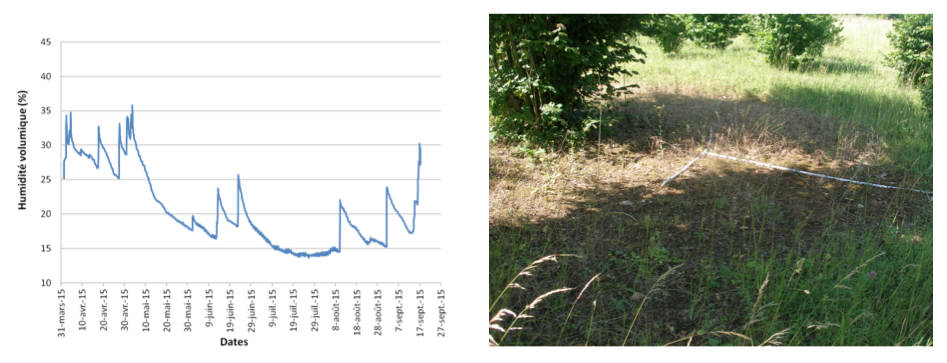Improving water management and effect of cultural techniques on soil truffle mycelium, truffle production and soil water balance: pilot experiences toward adaptation of truffle orchards to climate variations
PI : Claude Murat (UMR 1136 Interactions Arbres/Micro-organismes – IAM)
Co-applicants :
François Le Tacon (UMR 1136 Interactions Arbres/Micro-organismes – IAM)
Nathalie Bréda (UMR 1137 Ecophysiolgie et Ecologie Forestière – EEF)
Arnaud Legout (UR 1138 Biogéochimie des Écosystèmes Forestiers – BEF)
Collaboration :
Dominique Barry, ALCINA (private company)
Jean-Charles Savignac, Fédération Française des Trufficulteurs (FFT)
____________________________
Context — Truffles are ectomycorrhizal fungi naturally found in France and Lorraine. Some truffle species, such as the Perigord black truffle (Tuber melanosporum) and the Burgundy truffle (T. aestivum/T. uncinatum), produce fruiting bodies which are appreciated for their organoleptic qualities. The golden age of “trufficulture” occurred at the end of the nineteenth century and beginning of the twentieth century. Social and historical events (agricultural changes, world war..) lead to a decrease in production. Beginning in 1990, between 15,000-20,000 ha of new plantations have been planted using seedlings inoculated in nurseries which has effectively allowed French truffle production to stabilize. Today, truffle production faces two major challenges: (1) initiating sexual production, and (2) understanding how the growth of ascocarps over several months is linked to trees. Different biotic and abiotic factors can factor into both challenges. Hydric deficit, and consequently, the climate, are known to be crucial to truffle production but there remains a need for clear guidelines for managing truffle orchards in the context of global climatic changes.
Objectives — The ClimaTruf project was created to respond to requests from the truffle industry for innovative tools to effectively counter the effects of drought and adapt truffle cultivation to climate change. The initial objectives of ClimaTruf were to create models simulating the effects of global climate change on truffle production, to develop new tools for detecting and quantifying truffles in situ and to install and develop long-term experimental sites.
Approach —ClimaTruf is based on three work-packages:
- WP1 : Inventory of available metadata and sites where it will be possible to break down the soil water balance
- WP2 : Development of diagnostic kits to trace truffles
- WP2 : Installation of long-term experimental sites.
Key results —
- Using date provided by the French Ministry of Agriculture, we were able to extract statistics pertaining to truffle production from 1903 to 1988 in several different French departments.
- Private truffle growers provided production data for 10 T. melanosporum and 5 T. aestivum truffle grounds.
- Together with ALCINA, we developed protocol using qPCR with Taqman probes to detect two T. melanosporum mating type genes in soil. This protocol is commercially available through ALCINA.
- Humidity probes were installed in the Rollainville truffle orchards.
In Rollainville and in Vaucluse, a monthly sampling was initiated in March and June 2015 to assess the dynamic of both T. melanosporum mating types in the soil.
Main findings —
- We were able to confirm that a decrease in French production occurred over the twentieth century. However, we also observed that production (kg/ha) of single truffle fields has not decreased in the past 50 years which suggests that overall decline in production is mainly due to decreased surface area of truffle plantations.
- Using a mating type kit developed with ALCINA in Rollainville showed that both mating types were present in the soil, even where one mating type is absent at the root tips level. This demonstrates the important role ground mycelium play in initiating sexual reproduction.
- The kit developed with ALCINA has since been made available for commercial use and a know-how license has been issued, and is an excellent example of genomic resources being successfully transferred to for socio-economic contexts.
Future perspectives —
- To complete the climate/truffle production modeling.
- To continue the monthly mating type monitoring.
- To develop kits for detecting mating types for other truffle species.
- ClimaTruf data and tools justified the submission in 2015 of a joint project between INRA and FFT to FranceAgriMer which will start in 2016.



